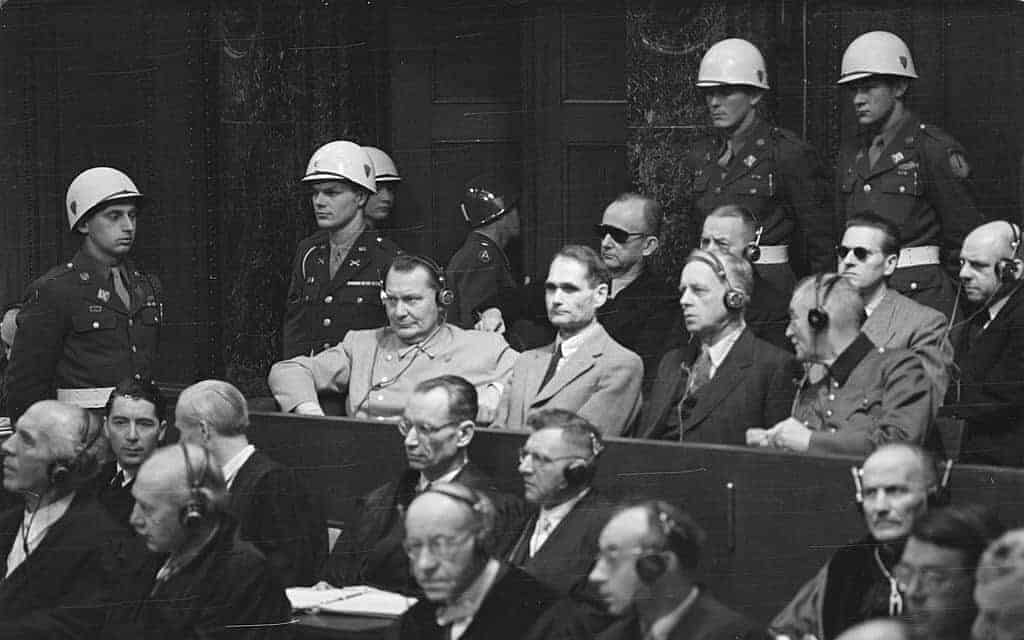Before Allied troops were on the continent of Europe, before the Russians began their drive to the west, before the bombing campaign wrecked the German capability of making war, the Allied leaders were discussing German war crimes and what to do about them. Churchill and Roosevelt both had knowledge of the German concentration camps and what was happening in them, reports of other atrocities were in the hands of the Allies. At the Tehran Conference Stalin suggested the execution of between 50,000 and 100,000 German officers and political leaders. Churchill, aghast at the idea of shooting soldiers who had served honorably, had earlier suggested the summary execution of leading Nazis.
The idea of trying a defeated enemy for crimes committed during the prosecution of war was not unprecedented. Following World War I, German officers accused of committing atrocities were tried in the German courts. The trials were largely a sham. The Allied Big Three discussed the format of the trials and the categories for which charges would be levied at Tehran in 1943, and Yalta and Potsdam in 1945. Although several of the leading Nazis escaped capture and execution by committing suicide (some while in custody) there were still about 200 trials held at Nuremberg, and over 1,600 in other jurisdictions. How many Nazi collaborationists were tried and executed by kangaroo courts is unknown.

Here are ten facts about the war crime trials which followed World War II in Europe, collectively known as the Nuremberg Trials.

Establishing the Tribunals
When representatives of what remained of the German government signed the Instrument of Surrender they recognized the authority of the Allies to charge individuals with violations of International Law and the Laws of War as defined by the Geneva Convention, Hague Convention, and others. This authority resided in the Allied Control Council, which established legal and governmental jurisdiction over all of Germany. In August 1945, the British, Americans, Soviets, and French created the legal basis for the trials, which were to focus on “…punishment of the major war criminals” whose crimes were committed after the outbreak of the war in 1939.
As the Germans who were to be tried in the first of the Nuremberg Trials were rounded up they were for the most part sent to the Palace Hotel in Luxembourg’s Mondorf-les-Bains, a spa town. They were not held in luxury. Hotel furniture was replaced with army cots and the remaining furnishings were spartan. The place was brightly lighted at night by klieg lamps, surrounded by coils of barbed wire, and patrolled by guards and guard dogs. The prisoners were allowed contact with attorneys who would represent them at trial, though they were not guaranteed an attorney being present when interrogated by military personnel. It was called Camp Ashcan.
The British operated a similar facility, even more spartan, in their sector. It was called Camp Dustbin. Dustbin was located in Castle Kransberg, a 12th century structure which had been rebuilt and modified under the direction of Albert Speer early in the war to serve as Hitler’s Western Front headquarters. When Hitler expressed his dislike of the facility, Speer modified it further for Luftwaffe use. Towards the end of the war Goering suggested Hitler seek a truce through Swiss contacts at Kransberg. The British used Camp Dustbin to hold senior Nazis who were from industry including Wernher von Braun, Ferdinand Porsche, and somewhat ironically, Albert Speer.
In August, the first group of prisoners to be tried before the tribunal were transferred to Nuremberg. Nuremberg was selected as the site for the trial after Leipzig, Berlin, and Luxembourg were rejected. The city had been a symbol of the Nazi Party and, more importantly, both a functional prison facility and the Palace of Justice were relatively intact, having survived the Allied bombing campaign. The tribunal was comprised of eight judges, a primary and an alternate, two each from the Soviet Union, United States, Great Britain, and France. Each also supplied a Chief Prosecutor to present the case based on the indictments through which the prisoners were charged.
As in civilian criminal trials, many of the witnesses called to present the cases against the accused were admitted participants in crimes, and worked with the prosecution in order to escape harsh sentences of their own. One of these witnesses was Rudolf Hoss, former commandant of the Auschwitz complex. Hitler’s former deputy, to whom he had dictated much of Mein Kampf while in prison in the 1920s, was the similarly named Rudolph Hess. Hess was brought from his imprisonment in England to stand trial before the first tribunal. He and Herman Goering were the most senior Nazi Party members to be tried at Nuremberg.

